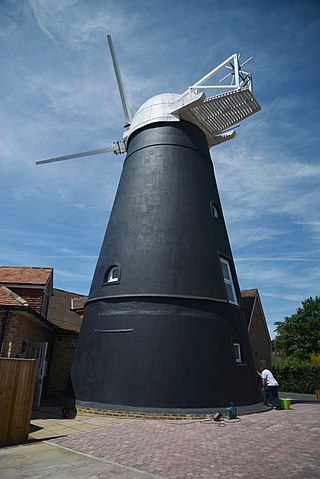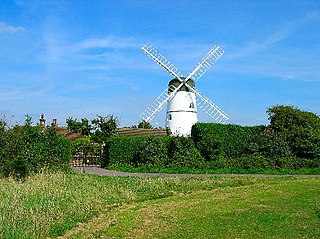
Heckington Windmill is the only eight-sailed tower windmill still standing in the United Kingdom with its sails intact.

The post mill is the earliest type of European windmill. Its defining feature is that the whole body of the mill that houses the machinery is mounted on a single central vertical post. The vertical post is supported by four quarter bars. These are struts that steady the central post.

A tower mill is a type of vertical windmill consisting of a brick or stone tower, on which sits a wooden 'cap' or roof, which can rotate to bring the sails into the wind.

Great Bircham Windmill is a Grade II listed tower mill in Great Bircham, Norfolk, England.

East Runton Windmill is a grade II listed tower mill at East Runton, Norfolk, England which has been converted to residential accommodation.

Bidborough Mill is a Grade II listed, house converted tower mill west of Bidborough, Kent, England. It is now incorporated into a housing development called Mill Court, on the south side of the B2176 Penshurst Road.

Meeten's Mill is a grade II listed smock mill at West Chiltington, Sussex, England, which has been converted to residential use.

John Baker's Mill is a grade II listed tower mill at Barnham, Sussex, England, which was under restoration and is now to be converted to residential use.

Waterhall Mill, also known as Westdene Windmill, is a grade II listed tower mill at Westdene, Sussex, England which has been converted to residential use.

Stone Cross Windmill is a grade II* listed tower mill at Stone Cross, East Sussex, England which has been restored and is open to the public. The mill was also known as Blackness Mill and the White Mill.

Walter's Mill is a tower mill at Mark Cross, Sussex, England which has been converted to residential accommodation.

Ashby's Mill, often referred to as Brixton Windmill, is a restored grade II* listed tower mill at Brixton in the London Borough of Lambeth. The mill was in Surrey when built and has been preserved.

Wray Common Mill is a grade II* listed tower mill at Reigate, Surrey, England which has been converted to residential use.

Terling Windmill is a grade II listed Smock mill at Terling, Essex, England, which has been converted to residential use.

Clavering Windmills are a pair of Grade II listed Tower mills in Clavering, Essex, England. They have both been converted to residential use. They are named North Mill and South Mill. A third mill existed in Clavering until the mid-nineteenth century, known as Clavering Mill.
Debden Windmill is a grade II listed Tower mill at Debden, Essex, England which has been converted to residential use.

Rayleigh Windmill is a grade II listed Tower mill at Rayleigh, Essex, England which has been restored as a landmark and is used as a museum.

Stansted Mountfitchet Windmill is a grade II* listed Tower mill at Stansted Mountfitchet, Essex, England which is also a Scheduled Ancient Monument. It has been restored and can turn by wind.

Stock Windmill is a grade II* listed tower mill at Stock, Essex, which has been restored.

Messing Maypole Mill is a grade II listed Tower mill at Tiptree, Essex, England which has been converted to a residence. Prior to boundary changes made when the civil parish of Tiptree was established in 1934, the mill was in the parish of Tolleshunt Knights.




















